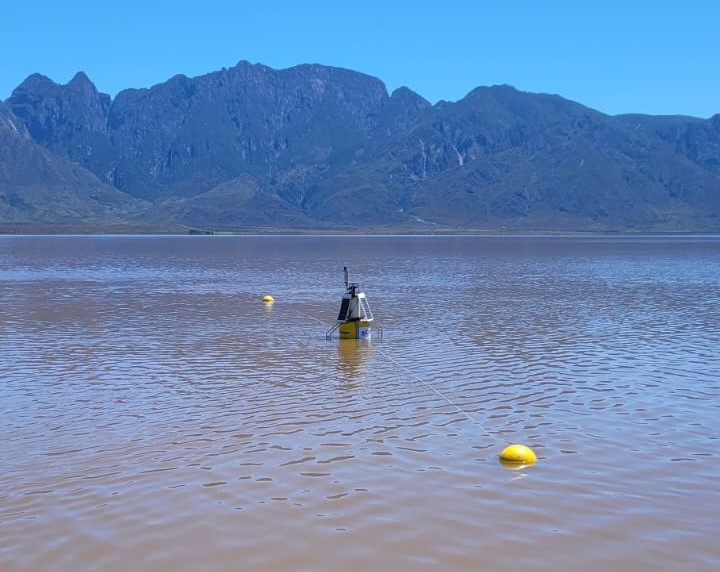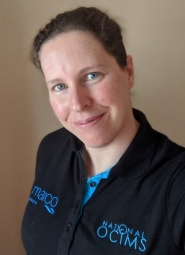CSIR deploys Africa’s only hyperspectral radiometric buoy in Theewaterskloof Dam to collect data on microalgae biodiversity
CSIR researchers deployed a buoy equipped with a series of instruments in Theewaterskloof Dam, one of the largest dams in the country, located in the Western Cape. The team of researchers aim to gain deeper insights into microalgae biodiversity and its significance in supporting the ecosystem health of South Africa’s drinking water dams.
The research team will employ a combination of satellite data and in-water physical and chemical measurements to assess microalgal diversity in near real-time. This approach will also enable the early detection of potential overgrowth of toxic algal species, which can negatively impact water quality and ecosystem stability.
Today, CSIR researchers deployed a buoy equipped with a series of instruments in Theewaterskloof Dam, one of the largest dams in the country, located in the Western Cape. The team of researchers aim to gain deeper insights into microalgae biodiversity and its significance in supporting the ecosystem health of South Africa’s drinking water dams.
The research team will employ a combination of satellite data and in-water physical and chemical measurements to assess microalgal diversity in near real-time. This approach will also enable the early detection of potential overgrowth of toxic algal species, which can negatively impact water quality and ecosystem stability.
The deployment and the data collected will form part of the BioSCape research project, an international collaborative research project built on deep scientific engagement between South Africa and the United States of America. BioSCape is funded by the United States government through the National Aeronautics and Space Administration (NASA), the South African government through the New Earth Observation Frontiers via the South African National Space Agency and the National Research Foundation, the South African Environmental Observation Network and the United Nations Educational, Scientific and Cultural Organization.
The BioSCape project employs a combination of remote sensing and field data to gain insights into the distribution, functionality and significance of biodiversity within the Greater Cape Floristic Region, recognised as one of the world’s 36 biodiversity hotspots. Biodiversity hotspots are regions that are biologically diverse and facing significant levels of habitat loss and degradation. Approximately 70% of plant species found in the Greater Cape Floristic Region are endemic to the area.
The growth and diversity of algae are closely linked to the prevailing light conditions in their environment, and the instruments aboard the buoy are equipped to make precise measurements of the underwater light field together with algal growth parameters. Currently, Theewaterskloof Dam is experiencing a significant sediment load due to the recent floods in the area. The dam is typically regarded as seasonally eutrophic with algal blooms occurring during the summer months.
Over the following three months, the anchored buoy, dubbed “Gizmo”, will be stationed in the dam, receiving regular visits for maintenance and upkeep. It is believed to be the only buoy in Africa that houses a hyperspectral underwater optical measurement system. The buoy was developed by CSIR’s Centre for Robotics and Future Production, to meet specifications determined by the Earth Observation and Coastal Systems research group, in collaboration with other local scientists and water quality management bodies. It will serve as the main radiometric data collection and aquatic validation site for the BioSCape airborne radiometric project.
The access-controlled area of the dam, in which the buoy will be deployed, is overseen as a nature reserve being managed by CapeNature. “CapeNature and the City of Cape Town must be acknowledged for their support of the BioSCape campaign, especially the Department of Water and Sanitation for the Theewaterskloof deployment,” says CSIR senior researcher, Dr Lisl Lain. The historical occasion has been made possible through close collaboration, as is evident from the assistance by the Department of Water and Sanitation to secure permits for deploying the buoy in Theewaterskloof Dam. The support received from Theewaterskloof Sports Club played an instrumental role in ensuring the successful deployment of the buoy today and is greatly appreciated by the CSIR.
This CSIR-developed buoy has previously been deployed on South Africa’s western and southern Cape coasts for harmful algal bloom research. “We have been updating the technology over the years to prepare for this moment to deploy the buoy in Theewaterskloof Dam in support of the high-quality data validation and vicarious calibration objectives of the BioSCape campaign,” says CSIR senior researcher, Dr Marie Smith.
From February to April 2024, the buoy will have a second deployment in Walker Bay for studies on similar water quality aspects. This is mainly in support of the aquaculture industry, which has suffered major financial losses over the years with toxic algae having become a huge threat to production.
“We will undertake community outreach and information dissemination about the buoy and its role following the deployment,” says Lain. “Water quality is an issue affecting all South Africans and the pursuit of a low-cost monitoring system is key for the management of this essential resource.”
In the coming weeks, the CSIR team will also be working with the NASA team members doing fieldwork from the middle of October until the end of November 2023 at some of the BioSCape target sites, namely Zeekoevlei, Rietvlei, Klein Rivier Estuary, Voelvlei Dam and Steenbras Dam.

-ENDS-
Issued by CSIR Strategic Communications
For more information, contact:
David Mandaha, CSIR Media Relations Manager
Tel: 012 841 3654
Mobile: 072 126 8910
Email: dmandaha@csir.co.za
About the CSIR:
The CSIR, an entity of the Ministry of Higher Education, Science and Innovation, is one of the leading scientific and technology research, development and implementation organisations in Africa. Constituted by an Act of Parliament in 1945 as a science council, the CSIR undertakes directed and multidisciplinary research and technological innovation, as well as industrial and scientific development to improve the quality of life of all South Africans. For more information, visit www.csir.co.za
Follow us on social media:
Twitter: @CSIR. Facebook: CSIRSouthAfrica. Instagram: CSIRSouthAfrica. LinkedIn: Council for Scientific and Industrial Research (CSIR). YouTube: CSIRNewMedia


